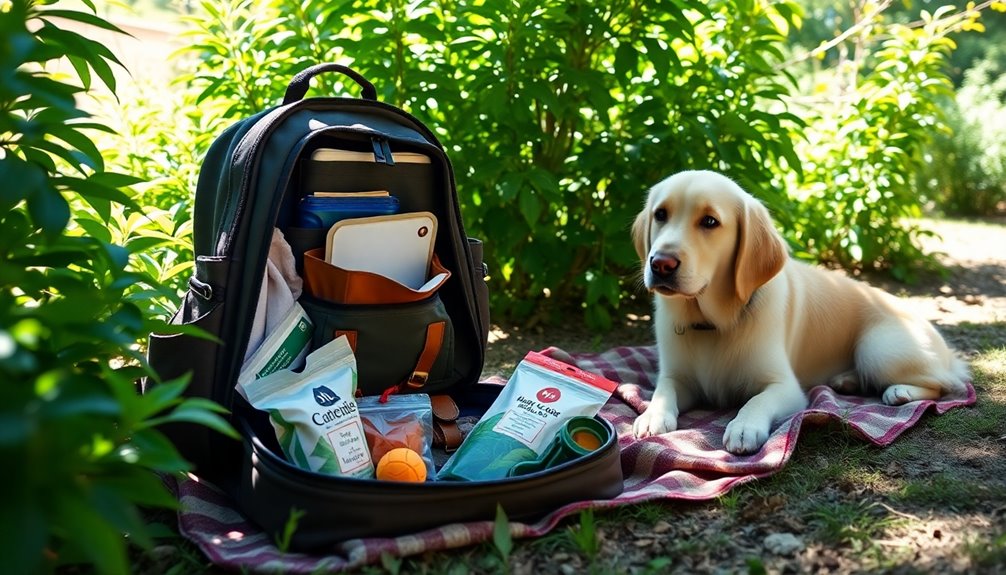When venturing into the wilderness with your dog, it’s crucial to know basic pet first aid to handle emergencies. Learn how to control bleeding, immobilize fractures, and recognize signs of shock or hypothermia. Be prepared for bites, stings, and poisoning, and know how to respond to choking or drowning. Carry essential supplies, create makeshift splints, and monitor your pet’s vital signs. Continue to explore these essential skills to keep your furry friend safe in remote areas.
Key Takeaways
- Learn basic first aid skills like bleeding control, splinting, and CPR tailored for dogs in remote environments.
- Recognize signs of common wilderness injuries such as trauma, snake bites, or shock for prompt stabilization.
- Use improvised tools and natural materials to splint, bandage, and safely transport injured pets.
- Manage temperature emergencies by cooling or insulating your dog to prevent hypothermia or heatstroke.
- Always carry a well-stocked pet first aid kit and monitor vital signs regularly during outdoor adventures.
Essential First Aid Skills for Outdoor Dog Emergencies

When your dog faces an emergency outdoors, having essential first aid skills can make all the difference. In the wilderness, knowing how to respond quickly is critical. Your first aid kit should include supplies to immobilize fractures with splints and control bleeding with direct pressure and pressure bandages. Recognize signs of shock, dehydration, and hypothermia to act promptly and stabilize your dog. Learning how to perform rescue breaths and CPR tailored for dogs can be lifesaving, especially when veterinary help is far away. Applying field techniques for wounds, burns, and snake bites helps prevent infections and worsened injuries. Regularly assess crucial signs like temperature, pulse, respiration, and capillary refill time (CRT) to evaluate your dog’s condition during an emergency. Utilizing specialized training can further improve your ability to respond effectively in outdoor situations. Additionally, understanding basic first aid principles enhances your preparedness for a variety of emergencies. Developing your emergency response skills ensures you’re ready to act confidently in critical moments, increasing your dog’s chances of recovery. Gaining a comprehensive understanding of first aid measures can also help you adapt techniques to unique outdoor scenarios and conditions. Remember that wilderness first aid techniques often require improvisation due to limited resources, making knowledge and confidence essential.
Recognizing and Managing Common Wilderness Injuries
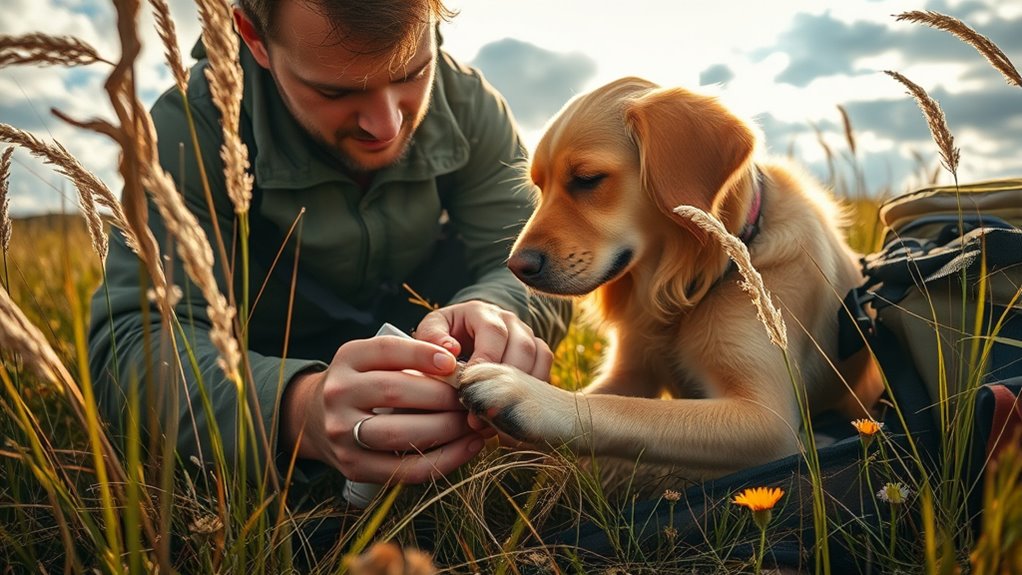
When your dog sustains an injury in the wilderness, quick recognition is key to effective care. Learn to identify common issues like cuts, fractures, or bites, and take immediate steps to stabilize your pet. Prevent accidents by staying alert and acting swiftly to manage injuries before professional help arrives.
Identifying Outdoor Injuries
Ever wonder how to quickly identify outdoor injuries in your dog during a wilderness adventure? Recognizing wilderness injuries starts with observing signs of trauma, like swelling, bleeding, limping, or unusual behavior. External wounds, such as cuts or punctures, need prompt assessment and proper bandaging from your pet first aid kit. Monitoring essential signs—heart rate, respiration, and gum color—helps determine if your dog is in shock or distress. Be alert for symptoms like excessive bleeding, difficulty breathing, or unresponsiveness, especially in remote emergencies where professional help isn’t nearby. Remember, early identification can make a critical difference. To stay prepared, familiarize yourself with these key indicators:
- Visible wounds or bleeding
- Limping or abnormal movement
- Swelling or deformity
- Changes in behavior
- Altered vital signs
Additionally, understanding vetted first aid products can ensure you have the right supplies for effective treatment. Recognizing wilderness injury signs early can help you act swiftly before further complications arise. Being knowledgeable about outdoor emergency procedures can also improve your response in urgent situations. Proper training and awareness of first aid techniques can significantly improve your ability to manage injuries until professional help is available. Developing mindfulness and observation skills enhances your capacity to detect subtle changes in your pet’s condition, which is crucial in wilderness settings.
Immediate First Aid Steps
Recognizing and managing common wilderness injuries quickly can make a significant difference in your dog’s recovery. In wilderness first aid, your first priority is assessing dog injuries by checking their behavior, physical appearance, and vital signs. Look for bleeding, swelling, deformities, or odors indicating infection. For bleeding control, apply pressure bandages to stop blood flow, and use splints for fractures to prevent further injury. Stabilization is crucial; ensure the dog’s airway, breathing, and circulation (ABCs) are maintained, and perform CPR if necessary. Address heatstroke or hypothermia with cooling or insulation. Knowing how to safely transport your dog—using improvised stretchers and secure restraints—can prevent additional harm during urgent care. Monitoring vital signs is essential to evaluate the dog’s condition continuously, especially considering the unpredictability of wilderness emergencies. Quick, decisive action can save your dog’s life.
Preventing Wilderness Accidents
Preventing wilderness accidents starts with understanding how to identify and avoid common hazards that can lead to injuries. Recognizing potential risks helps you implement injury prevention strategies and reduces the chance of wilderness injuries. To stay safe, focus on:
- Using proper leash techniques to ensure dog safety
- Avoiding hazardous terrain and unstable surfaces
- Staying hydrated to prevent dehydration and heat-related illnesses
- Monitoring for signs of hypothermia or hyperthermia
- Managing bite wounds and insect stings promptly
- Being aware of dog breeds that may have specific health concerns or temperaments suited for outdoor activities
Mastering first aid techniques for field injuries, such as applying splints or pressure bandages, can stabilize your pet until help arrives. Being prepared for remote emergencies by knowing injury management methods is essential for accident prevention and ensuring your pet’s safety during outdoor adventures.
Handling Bite, Sting, and Poisoning Incidents
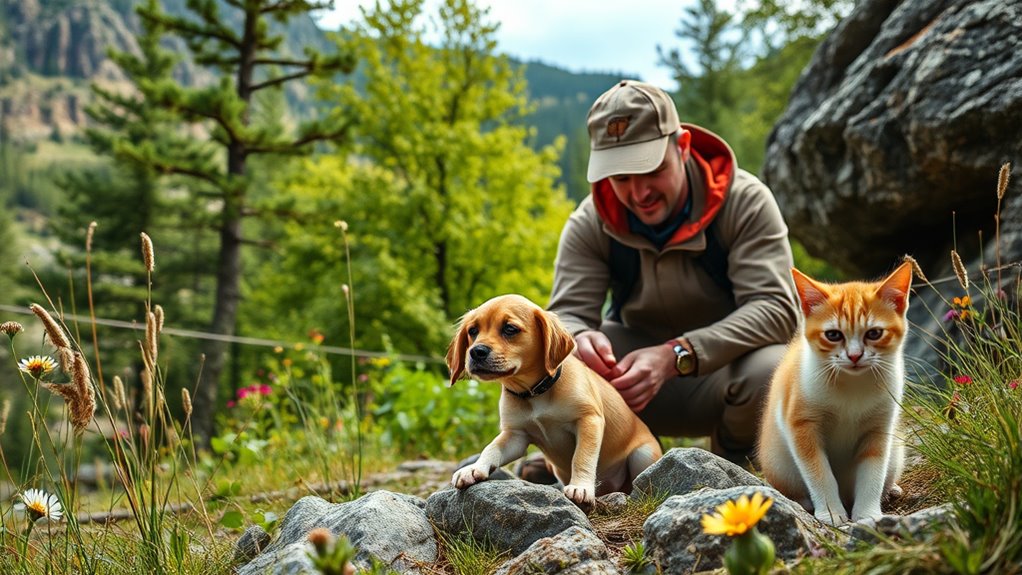
When your dog is bitten, stung, or poisoned, quick and calm action can make all the difference. For a bite or sting, keep your dog as still as possible to slow venom spread, and gently remove any ticks with tweezers. Monitor for allergic reactions like swelling or difficulty breathing; if they occur, administer vet-approved antihistamines if instructed. In case of poisoning, identify the substance if you can, rinse the area with water, and contact a veterinarian or poison control immediately. Always keep your dog on a leash and avoid wildlife in wilderness areas to prevent bites and stings. Proper first aid helps stabilize your dog until professional treatment can be provided. Recognizing symptoms of poisoning can help you act swiftly to minimize harm. Additionally, having First aid supplies readily available can also help improve your dog’s comfort and safety during outdoor adventures. Knowing how to recognize signs of poisoning symptoms can ensure prompt care and prevent further harm.
Preventing and Treating Hypothermia and Heat-Related Issues

To keep your dogs safe from hypothermia and heat-related issues, understanding how to prevent and treat these conditions is crucial. Hypothermia occurs when their core body temperature drops below 98°F, causing shivering, lethargy, and confusion. Heatstroke, on the other hand, results in rapid panting, vomiting, bright red gums, and collapse, requiring immediate cooling. During outdoor activities, monitor your dog’s temperature, pulse, and gum color to catch early signs. To prevent these issues, insulate your dog from cold surfaces, provide shade, and ensure access to fresh water. It is also important to monitor environmental conditions to anticipate potential hazards. Being aware of proper hydration can further help prevent heat-related illnesses. In an emergency, first aid involves gradual cooling for heatstroke and warming measures for hypothermia. Always be prepared to act quickly to provide emergency care. Regularly checking air quality indicators can also help in assessing environmental safety for your pet. Additionally, using an air purifier in your home can reduce indoor pollutants that may affect your pet’s respiratory health. Ensuring your dog’s living environment is well-maintained and free of indoor pollutants supports overall health and resilience against extreme temperatures. – Use blankets or thermal mats for insulation. – Cool with soaked towels, water, or fans. – Avoid sudden temperature changes. – Keep dogs in shaded, breezy areas. – Monitor vital signs regularly.
Responding to Choking, Drowning, and Respiratory Distress
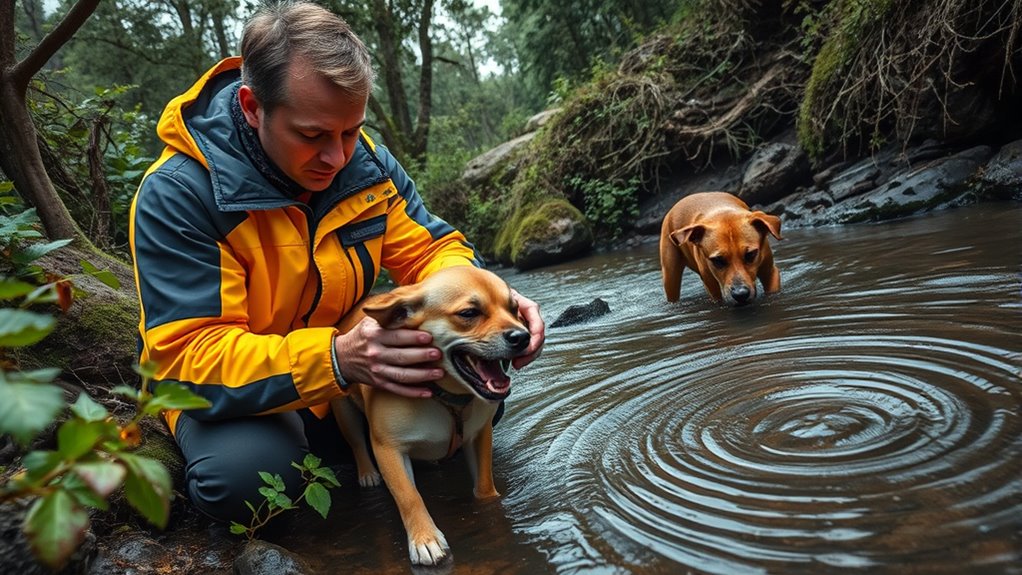
Responding quickly to choking, drowning, and respiratory distress can save your dog’s life. For choking, gently lift the hindquarters and tilt the head downward to dislodge the object, avoiding finger sweeps that might push it deeper. In a pet emergency involving drowning, approach from downstream or use a branch to reach the dog safely; don’t risk entering fast-moving water. If your dog becomes unconscious from drowning, perform rescue breaths by sealing the mouth or nostrils and breathing into the nose, monitoring for signs of recovery. Recognize respiratory distress through rapid, labored breathing, pale or bluish gums, or collapse. Keep your dog warm and calm, and seek veterinary care immediately. Being aware of necessary cookies and privacy policies can help you stay informed about site resources related to pet emergency preparedness.
Managing Wounds, Bleeding, and Trauma in Remote Settings
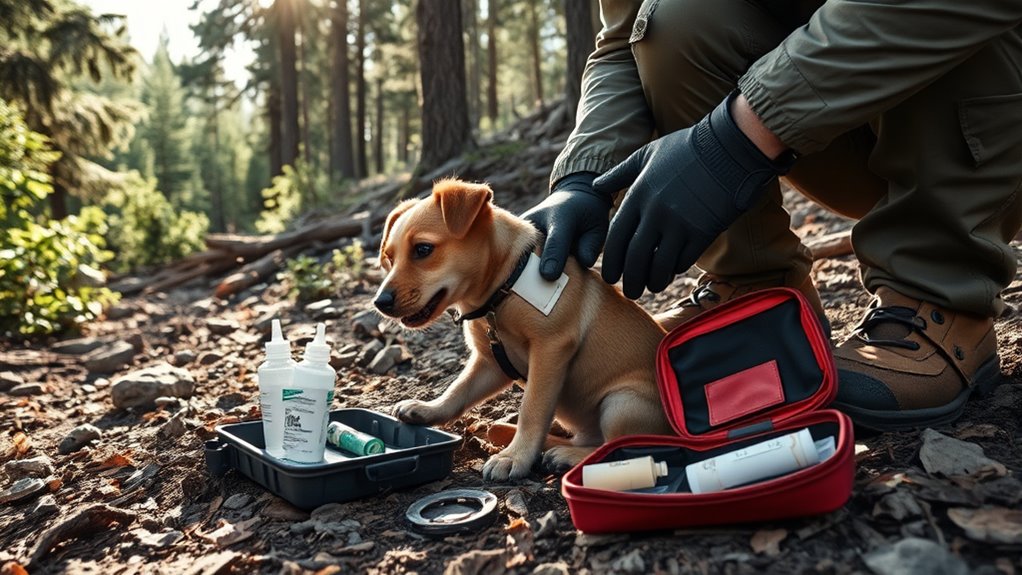
When your dog sustains a wound or bleeding in a remote setting, your first step is to apply direct pressure with a sterile or clean cloth to control bleeding. Elevate the injured limb and keep your dog calm to help reduce blood flow, while using makeshift splints to stabilize fractures. Properly cleaning wounds and watching for signs of shock are essential to prevent infection and ensure urgent care if needed.
Controlling Bleeding Effectively
Controlling bleeding effectively in remote settings requires quick and decisive action. Start by applying direct pressure with sterile gauze or a clean cloth to control bleeding and prevent blood loss. Elevate the injured limb above the heart if it doesn’t cause additional pain or injury. Use a pressure bandage to secure the dressing firmly. Only as a last resort, consider applying a tourniquet for severe arterial bleeding that can’t be stopped with direct pressure—be careful to avoid further tissue damage. Recognize the type of bleeding: bright red, pulsatile blood indicates arterial bleeding needing immediate control. Keep your pet calm and immobilized to prevent increased bleeding. Remember, timely remote veterinary care is critical for proper recovery.
- Apply pressure correctly
- Know when to use a tourniquet
- Recognize arterial bleeding
- Elevate safely
- Stay calm and monitor vital signs
Managing Wound Care
Effective wound care in remote settings begins with prompt cleaning to reduce the risk of infection. Use clean water or eyewash to gently rinse the injury, removing debris. Apply a sterile dressing to protect the wound and prevent infection. To control bleeding, apply firm pressure with gauze or a clean cloth, elevate the limb if possible, and use a pressure bandage if bleeding continues. For trauma, immobilize fractured limbs with available materials like splints or slings to minimize pain and prevent further injury. Recognize signs of shock, such as pale gums, rapid pulse, and weakness; keep your pet warm and elevate the hindquarters if needed. Proper wound care helps stabilize your pet until veterinary help is accessible.
| Action | Method | Purpose |
|---|---|---|
| Wound cleaning | Rinse with clean water or eyewash | Infection prevention |
| Bleeding control | Apply firm pressure and elevate | Stop bleeding |
| Trauma immobilization | Use splints or slings | Reduce pain, prevent injury |
| Covering wounds | Use sterile, non-adhesive bandage | Protect wound, infection prevention |
Using Improvised Equipment for Rescue and Stabilization
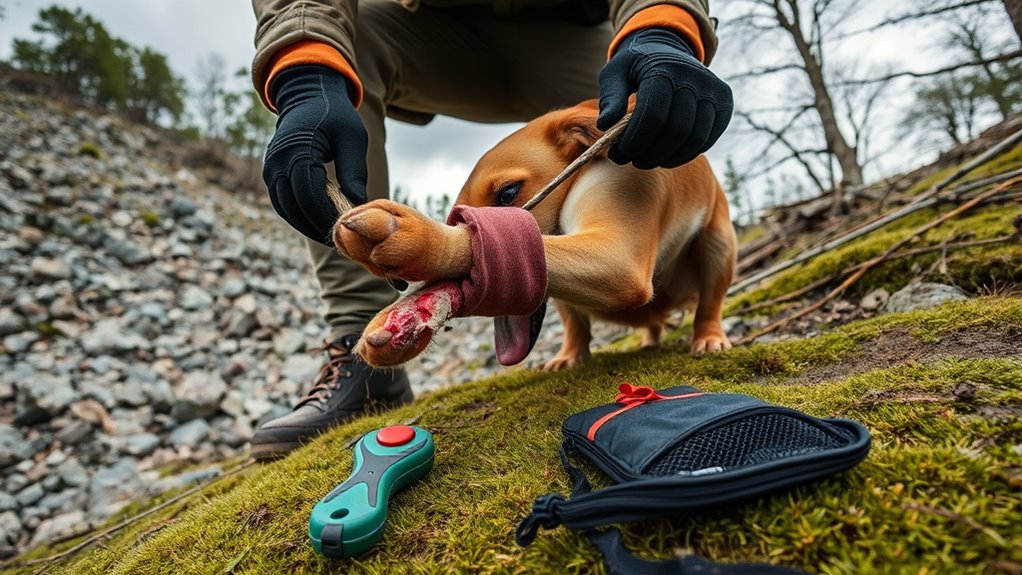
In emergency situations where commercial rescue supplies are unavailable, you can create effective makeshift equipment using everyday outdoor items. Improvised equipment can help stabilize injured dogs and assist in rescue efforts, especially when you lack proper tools. Use sturdy sticks or branches to make makeshift splints for broken limbs, ensuring they’re immobilized. Rolled-up clothing or blankets serve as slings to support and secure injured dogs during rescue. Water bottles or rocks wrapped in cloth can act as weights or splints to control bleeding or immobilize fractures. Ropes, cords, or shoelaces help secure splints or facilitate hoisting and dragging. Common outdoor items like branches can be fashioned into stretchers, enabling you to transport injured dogs safely across rough terrain when proper rescue gear isn’t accessible.
- Think creatively with what’s around you
- Prioritize stabilization to prevent further injury
- Use natural materials for support and immobilization
- Secure everything tightly but comfortably
- Always ensure safety for both you and the dog
Monitoring Canine Vital Signs and Behavioral Cues

Monitoring your dog’s essential signs and behavioral cues is important during emergencies, as it helps you assess their condition and identify signs of distress early. Regularly checking vital signs like temperature (101-102.5°F), pulse (60-160 bpm), and respiration rate (10-30 breaths per minute) provides insight into their overall health. Behavioral cues such as excessive panting, drooling, whining, or restlessness can indicate pain or stress. Changes in gum color and capillary refill time help evaluate circulatory status, with pale, blue, or brick-red gums signaling issues. Observing body language—flattened ears, lowered tail, avoiding eye contact—can reveal discomfort or fear. Consistent monitoring of vital signs and behavioral cues during emergencies allows you to detect deterioration early and act swiftly to support your canine’s health.
Preparing for Emergencies: Equipment, Planning, and Safety Tips
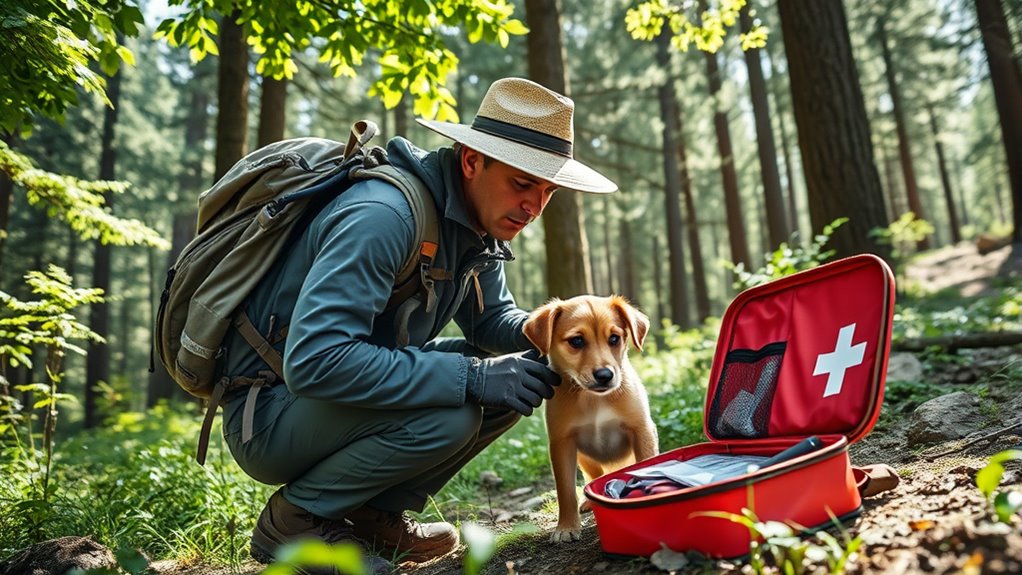
Preparing for emergencies starts with assembling the right equipment, creating a clear plan, and ensuring safety measures are in place. Your pet first aid kit should be well-stocked with essentials like gauze, antiseptic wipes, and a digital thermometer. Develop an emergency plan that includes nearby veterinary clinics, rescue services, and reliable communication methods, especially for remote areas. Practice safety tips like keeping your dog secured with a microchip and identification tags. Regularly inspect your gear, such as life jackets and protective booties, to confirm they’re in good condition. Training your dog for emergency scenarios, including restraint and evacuation techniques, boosts your preparedness. Remember, thorough planning and proper equipment can make all the difference during water activities or unexpected crises in wilderness settings.
Frequently Asked Questions
What Is the Difference Between Wilderness First Aid and Regular First Aid?
The current question asks about the difference between wilderness first aid and regular first aid. You’ll find that wilderness first aid focuses on providing immediate care in remote areas where professional help might be hours or days away. You’ll learn to improvise using available resources, handle unique scenarios like hypothermia or snake bites, and stabilize injuries until help arrives. Regular first aid, by contrast, is simpler, suited for everyday injuries in accessible environments.
What Is Level 3 Pet First Aid?
Level 3 Pet First Aid is an advanced certification that equips you to handle complex emergencies involving pets. You’ll learn to triage injuries, stabilize animals, and manage severe conditions like fractures or shock. This training prepares you for remote situations, enabling you to coordinate rescue efforts and provide critical care in challenging environments. With a two-year certification, you demonstrate a high level of expertise in emergency pet care.
What Should Be in a Pet Emergency Kit?
You should include essential items like sterile gauze, non-adhesive bandages, and vet wrap to handle wounds. Add antiseptic solutions, disposable gloves, and scissors for infection control. A digital thermometer and a pet-specific first aid manual help monitor crucial signs and guide you. Don’t forget a leash, muzzle, and rescue sling for safe restraint, along with tick removal tools and sting relief to be fully prepared for any emergency.
Conclusion
Remember, being prepared is your best leash in the wilderness. With the right first aid skills, you’re the shepherd guiding your dog through the wild’s unpredictable storms. Stay calm, act swiftly, and trust your instincts—you’re the anchor in their moment of need. Think of yourself as a guardian angel, ready to patch wounds and calm fears, ensuring the adventure continues safely, no matter what surprises the wilderness throws your way.






